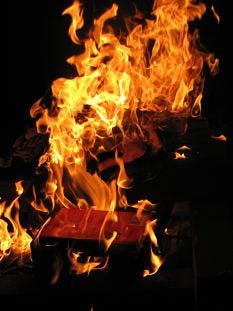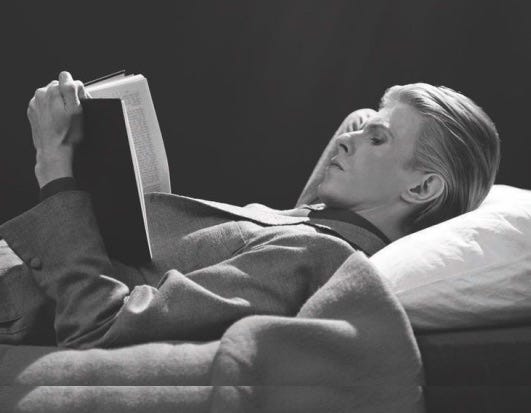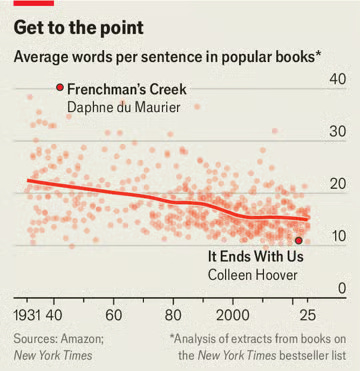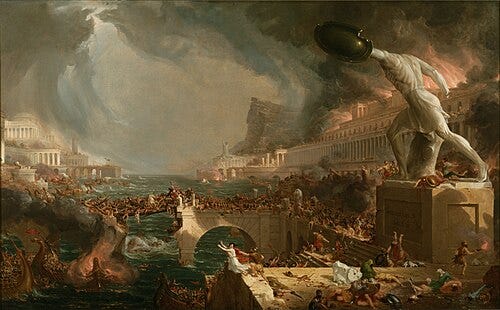We Need a Reckoning on the 1619 Project
- By Peter Wood
- January 30, 2025

Editor's Note
Like all revolutionary movements, the destructive Left cannot achieve its goals without convincing enough people that the old order is so evil it can only be destroyed. This is the purpose served by Critical Race Theory and, more specifically, by the New York Times’ 1619 Project, which cast slavery as the foundational principle of the United States. The project’s educational component has been hugely influential but, as Peter Wood points out, the actual numbers on its reach are unclear and even conflicting. Wood argues that a clear accounting of the propaganda’s reach in American schools will be a necessary, if difficult, step in any course correction.
The New York Times launched its torpedo at American history on August 18, 2019. I speak, of course, of “The 1619 Project,” which first emerged as a special edition of the newspaper’s Sunday magazine. In the ensuing five years and five months, the 1619 Project outgrew its original 100 pages of newsprint. It became a somber 50 second television commercial on February 9, 2020, that aired during the Academy Awards and featured the singer, song-writer, and actress Janelle Monáe. In 2021, it ballooned into a 590-page hardback book, supertitled “A New Origin Story.” In 2023, Hulu turned it into a six-part “docu-series” with Oprah Winfrey as executive producer.
During those five-plus years, the New York Times ran thousands of print advertisements for the “project.” It substantively revised the magazine text without any public acknowledgment, which means unless you saved the original copy, you can’t know exactly what it said.
One thing it said, on the inside back cover, was that the 1619 Project was on its way to the nation’s schools as a curriculum, including “a lesson plan that introduces this issue [of the magazine], summaries of the articles, an index of historical terms used, suggested activities that engage students creatively and intellectually and opportunities to connect with New York Times journalists featured in this issue.”
That declaration came from the Pulitzer Center, a nonprofit founded in 2006 that attempts to amplify journalism that it judges to have broad public importance. It describes itself as “the venue for the world’s most innovative and consequential reporting, with journalism as the key element for mobilizing society through audience engagement strategies.” In other words, the Pulitzer Center is an activist organization that eschews the old journalistic ideal of providing the information people need to decide for themselves. It instead seeks to “mobilize” the public. And, as it happens, the reporting it selects for this mobilization is entirely of a progressive character.
Before the New York Times unleashed the 1619 Project, it entered into an agreement with the Pulitzer Center, in which the center became the Times’ “educational partner” for the project. The center assumed the task of translating the 1619 Project into “programs for K-12 Classrooms, out-of-school time programs, and higher education programs.”
Most of what we now know about how the 1619 Project has entered into the nation’s schools comes from the Pulitzer Center’s reports on its success. These have to be read judiciously. The Pulitzer Center doesn’t want to disappoint the New York Times, but it also has to guard against playing into the hands of critics, including elected officials who oppose the use of the 1619 Project in public schools. In that light, the Pulitzer Center takes care to report only the facts and figures that come directly from its own efforts to market the project. The readiness of teachers and schools to adopt the project on their own goes unrecorded.
The most recent report from the Pulitzer Center comes from an October 2024 “learning webinar,” but it is mostly anecdotal — though richly informative nonetheless. One of the participants oversaw the implementation of the 1619 curriculum in Buffalo as part of the Buffalo School District’s “Emancipation Curriculum.” She brought the 1619 Project to “60 school buildings, reaching over 30,000 students.”
Another speaker, Theresa Maughan, was New Jersey’s 2022 Teacher of the Year, and the leading figure in the East Orange STEM Academy’s 1619 Project program called “Teaching to Transgress.” She takes pride in having brought science teachers into the fold by focusing on “race, medicine, and health equity.” Those were indeed part of the original 1619 Project.
Shamia Truitt-Martin, a social studies teacher in the Carrington Middle School in Durham, North Carolina, “partners with North Carolina State University on the iScholar initiative where she develops culturally-informed STEM lesson plans with an interdisciplinary focus.” Her focus was on developing lessons on “Durham’s Black Wall Street and its place in American history.” Her testimonial began, “It all started because of our wonderful 1619 Project book that we love immensely. Right? We basically read it inside and out and knew everything about it.”
The focus of these participants was on the success of the 1619 Project in their own schools and districts, which appears considerable, but this tells us nothing about the national picture. The Pulitzer Center’s third quarter report offers one clue: It claims that its efforts to promote the 1619 Project “directly impacted 28,000+ teachers and students and created curricular resources that reached over 1.5 million people.” This appears under a headline “Reaching more than 2,800 students and teachers,” which I trust is a typo. But there is something else odd about the claim: Fatima Morrell says that she reached 30,000 students in Buffalo alone. Does the Pulitzer Center mean that it recruited 28,000 teachers?
Elsewhere, the Pulitzer Center throws up other numbers. In “Five Years of Teaching The 1619 Project,” we learn that the Center has built a “network of 541 educator partners” and has “reached 25,000 students in pre-K-12th Grade and 2,500 adult learners.” And: “We have facilitated 203 events and workshops attended by over 15,000 people, and published over 100 curricular materials on our award-winning 1619education.org website, which has been viewed over 400,000 times by people in all 50 states and Washington, D.C.” Back in 2020, the Pulitzer Center claimed that the Project was being used in more than 4,500 schools across the nation — that is, roughly 1 out of every 25 U.S. schools.
Given the massive investments made in promoting the project, these seem like paltry numbers. The hardback book version of the 1619 Project sold 45,000 copies in the second week after it was released in December 2021. The TV mini-series attracted more than 1.6 million viewers on May 31, 2023. These are cultural footprints much larger than the Pulitzer Center’s shoes.
Of course, adult readers and television audiences may reflect dynamics that differ sharply from what happens in school districts and among teachers. But the 1619 Project also comes with the significant propulsion of the nation’s leading teachers union, the National Education Association, which has touted it from the start and continues to promote it as a resource “to support racial justice in the classroom.” This just doesn’t compute with only 541 “education partners” reaching 25,000 students over five years. Those numbers must represent the Pulitzer Center’s focus on a narrow count. Tens of thousands of teachers could be teaching 1619 Project-derived lesson plans without having registered with the Pulitzer Center as “education partners.”
But apparently no one knows, and there is no easy way to find out. I would say that there are abundant indications that the 1619 Project has greater traction in the nation’s schools than the Pulitzer Center’s data suggest. In fall 2020, the education journalist Naomi Schaefer Riley asked around at schools in Chicago, Baltimore, and Concord, Massachusetts, where she found teachers enthusiastically embracing it. I have had similar experiences whenever I’ve talked to teachers. Not every teacher endorses it, but almost every teacher knows about it and feels free to draw on it.
So we are left with a yawning question about how deeply the 1619 Project has penetrated our schools. When it comes to colleges and universities, however, there is much less room for doubt. The membership of the American Historical Associations rose up in fury in 2022 when its president, James Sweet, offered some timid criticism of the project for trying too hard to read the past through the prism of the present. Sweet issued a groveling apology.
I am writing in this essay about how deeply the 1619 Project has penetrated schools, not colleges, and I have paid the barest attention to the project’s many critics. At least four books have been published that aim at discrediting the 1619 Project: in order of publication, Phillip W. Magness’s The 1619 Project: A Critique; my 1620: A Critical Response to the 1619 Project; David North and Thomas Mackaman’s The New York Times’ 1619 Project and the Racialist Falsification of History; and Mary Grabar’s Debunking the 1619 Project: Exposing the Plan to Divide America. North and Mackaman’s book collects a series of essays that first appeared on The World Socialist website in fall 2020, rewritten by a variety of eminent historians.
So the 1619 Project has not gone unattended by people who have paid serious attention to the facts. Nor has it gone unnoticed by state and national political leaders. Perhaps most noteworthy was President Trump’s response in September 2020, when he announced he was forming a “1776 Commission” to produce a better curriculum. That venture came to a meagre result because time ran out before President Biden took office, and Biden promptly abolished the Commission. Still, the sense that the 1619 Project posed a serious danger to the quality of American history and social studies education remained in the public mind, at least among conservatives.
The faults in the 1619 Project are many and egregious. The shortest summary is that it collapses all of American history into a tale of racial oppression. Some of its claims are factually correct; many are not. But the overall claim is egregiously false, and the alarm it has occasioned arises principally from the authors’ aim of teaching this false narrative to American school-age children.
Critics of all races, from Trumpian conservatives to Trotskyite socialists, have raised their voices, but seemingly to little effect. In 2021, legislators in Arkansas, Iowa, South Dakota, Texas, Missouri, Florida, and Mississippi introduced bills to ban the teaching of the 1619 Project in public schools. The Arkansas bill failed. Iowa passed a bill banning the teaching of “divisive concepts,” which did not explicitly mention the 1619 Project. South Dakota’s governor issued an executive order banning the state’s department of education from applying for federal grants tied to critical race theory. The Texas bill, which more broadly attacked “critical race theory,” passed. It said, “A teacher may not require an understanding of the 1619 Project.” The Missouri bill stalled and continues to be debated. In Florida, the state board of education banned the 1619 Project in 2021, and the legislature passed the Stop WOKE Act in 2022, effectively banning the 1619 Project. In Mississippi the bill failed.
This is to say that public opposition to teaching the 1619 Project in schools has so far not yielded much in the way of results. Perhaps it has been eclipsed by concern over the active promotion of transgenderism in the schools. But repairing schools is a terribly difficult problem for those bent on reform. The unions stand in the way. The traditional autonomy of teachers stands in the way. School boards, usually aligned with the teachers unions, stand in the way. The progressive ideology, driven by schools of education, stands in the way. Above all, the opacity of American schools stands in the way. It is very difficult for parents, citizens, or political leaders to find out just what teachers are teaching.
The Covid epidemic briefly poked a hole in the screen that hides the curriculum from the outside world. That fed the initial rebellion against the 1619 Project. But with the return to in-person instruction, the curtain has once again descended.
One thing the U.S. Department of Education could do is impose strict reporting requirements on schools to report what texts and teaching materials they use to teach history and social studies. As it is, no one knows how deeply institutionalized the 1619 Project has become.
But we should find out. In some sense, the future of our nation may depend on it.
Authors
Peter Wood
Peter Wood is the president of the National Association of Scholars. A former professor of anthropology and college provost, he is the author of several books about American culture, including Diversity: The Invention of a Concept (2003) and Wrath: America Enraged (2021). He is the editor in chief of the journal Academic






























